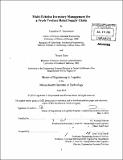Multi-echelon inventory management for a fresh produce retail supply chain
Author(s)
Suryawanshi, Yogeshwar D. (Yogeshwar Dattatraya); Hsien, Thomas
DownloadFull printable version (18.73Mb)
Other Contributors
Massachusetts Institute of Technology. Engineering Systems Division.
Advisor
Amanda Schmitt.
Terms of use
Metadata
Show full item recordAbstract
Perishability presents a challenging problem in inventory management for the fresh produce industry since it can lead to higher inventory costs and lower service levels. If a supply chain has multiple echelons, that further complicates the issue since companies have an added risk of not having the right amount of product at the right location at the right time. We conduct our research on Chiquita's Fresh Express supply chain. We analyze the impact of perishability on total relevant costs. Our research focuses on determining the optimal inventory policy for the system considering inventory holding costs, shrinkage costs, lost sales costs, forecast accuracy and service levels. We test the sensitivity of the system with respect to forecast errors and the transportation lead time. We developed a discrete-event simulation model using Arena software to conduct the research. Our research demonstrates that by lowering the current target on-hand inventory levels at the distribution center and retail stores, inventory holding costs and shrinkage costs are reduced significantly. Under the optimal inventory policy, the system can save 31% in costs, improve the item fill rate at the distribution center, reduce the total shrinkage volume, and maintain high service levels of more than 95% at the retail stores. Our sensitivity analysis shows that the system is very sensitive to the forecast errors. Additionally, we recommend keeping the transportation lead time as low as possible to maximize the products' lifetime at the retail stores. Reducing the forecast errors or the transportation lead time would reduce the total relevant cost of the system while improving the item fill rates across the supply chain.
Description
Thesis (M. Eng. in Logistics)--Massachusetts Institute of Technology, Engineering Systems Division, 2010. Cataloged from PDF version of thesis. Includes bibliographical references (p. 83-84).
Date issued
2010Department
Massachusetts Institute of Technology. Engineering Systems DivisionPublisher
Massachusetts Institute of Technology
Keywords
Engineering Systems Division.